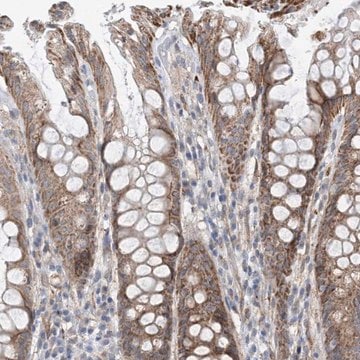03353621001
Roche
5′/3′ RACE Kit, 2nd Generation
sufficient for 10 reactions
About This Item
Recommended Products
usage
sufficient for 10 reactions
Quality Level
manufacturer/tradename
Roche
shipped in
dry ice
storage temp.
−20°C (−15°C to −25°C)
Related Categories
General description
Specificity
Transcriptor Reverse Transcriptase: 85 °C for 5 minutes
Application
- Structural and expression studies of RNA molecules
- Generating full-length cDNAs
- Isolation and characterization of 5′ or 3′ ends from low-copy RNA messages
- first strand cDNA synthesis
- Amplification and further cloning of rare mRNAs
- Use in conjunction with exon-trapping methods
- Products of the RACE reaction can be directly sequenced without cloning
Features and Benefits
- Robust performance: Recombinant Transcriptor Reverse Transcriptase allows procession through regions of difficult secondary RNA structure.
- Convenient: Function and expression studies of either 5′ or 3′ end of the RNA can be performed with the same kit.
- Reliable: dA tailing of cDNA with Recombinant Terminal Transferase decreases the likelihood of inappropriate truncation.
- Reproducible: Oligo dT-anchor primer with non 3′dT ensures correct binding to the inner end of the poly (A) tail.
- Produce long fragments: Generate cDNA up to 14kb in length with Transcriptor Reverse Transcriptase.
Packaging
Other Notes
Kit Components Only
- cDNA Synthesis Buffer 5x concentrated
- Transcriptor Reverse Transcriptase 20 U/μl
- Deoxynucleotide Mix
- dATP, pH 7.5 (20 °C)
- Reaction Buffer 10x concentrated
- Terminal Transferase, recombinant
- Control neo-RNA 1 ng/μl
- Oligo dT-Anchor Primer
- PCR Anchor Primer
- Control Primer neo1/rev primer 12.5 μM
- Control Primer neo2/rev primer 12.5 μM
- Control Primer neo3/for primer 12.5 μM
Storage Class Code
12 - Non Combustible Liquids
WGK
WGK 1
Flash Point(F)
does not flash
Flash Point(C)
does not flash
Certificates of Analysis (COA)
Search for Certificates of Analysis (COA) by entering the products Lot/Batch Number. Lot and Batch Numbers can be found on a product’s label following the words ‘Lot’ or ‘Batch’.
Already Own This Product?
Find documentation for the products that you have recently purchased in the Document Library.
Customers Also Viewed
Articles
In addition to the troubleshooting provided in the product manual, most probably the efficiency of the tailing reaction performed by Terminal Transferase could be impaired. This could occur due to several reasons (which will not only affect the control reaction, but 5′ RACE in general):
Our team of scientists has experience in all areas of research including Life Science, Material Science, Chemical Synthesis, Chromatography, Analytical and many others.
Contact Technical Service










